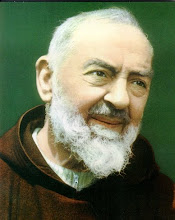Jesus tells us in Matthew 6:7 “When you are praying do not use
meaningless repetition as the Gentiles do for they suppose they will be
heard for their many words.”
All Catholics should be familiar with
this verse; it is thrown at them by anti-Catholics frequently enough for
all of us to have heard it close to one million times. And, I daresay,
some Catholics are guilty of praying vainly and repetitiously, thinking
that if they merely say the words they are praying. I remember being
younger, sitting restless in my pew, Rosary in hand, mouthing the words
along with everyone else as I remembered the movie that I had seen the
night before. The Rosary! The height of Catholic repetitious prayer!
Taking at most twenty-minutes to say and consisting of fifty-three Hail
Marys (among other prayers), is it any wonder it seems mind-numbingly
repetitive to those non-Catholics who don’t understand it? No, it isn’t.
But, to those of us who understand it, it is not repetitious at all,
and it is far from meaningless. So, the question is, “What is the
Rosary?”
For years too many to count, monks and religious would pray
the 150 Psalms of the Bible as part of their daily prayer. Many of the
common folk would have imitated this pious practice and prayer; however,
they could not read. Therefore, something had to be offered them which
they could pray. The answer? The Paternoster Beads, as they came to be
known as: 150 Our Fathers, divided into fifties, and kept track of by
counting pebbles into a bowl or knots onto a string. Time passed, and a
parallel Psalter came about: the Marian Psalter, prayed with the “Hail
Mary” instead of the “Our Father”. Saint Dominic was a great promoter of
the Marian Psalter. While in France fighting against the Albigensian
heresy, he would preach the life and death of Jesus Christ while
simultaneously praying the Marian Psalter. It is said that Mary appeared
to Dominic during his missionary work and told him to continue praying
her Psalter while meditating upon the life of her Son. Over time, the
150 Hail Mary prayers were divided into three sets of fifty, and each
set was divided into five decades. Specific points in Christ’s life and
death came to be meditated upon. They came to be known as the “Sorrowful
Mysteries,” the “Joyful Mysteries,” and the “Glorious Mysteries”—each
group consisting of five points in Christ’s life, and so one mystery for
each decade. These three sets of Mysteries were officially approved by
Pope Pius V in 1569. In October 2002, Pope John Paul II added another
set of Mysteries—the “Luminous Mysteries”—therefore bringing the number
of decades up to twenty. Hence was born the Rosary as we know it today.
Why
is all this important? One must remember that Catholics do not merely
say the Rosary. Catholics pray the Rosary. It is not meaningless
utterance of myriad Hail Marys! Rather, the Rosary is a continued
meditation of the Life and Death of Jesus Christ. While one is saying
the Hail Mary, they are (or should be) simultaneously remembering every
moment in Jesus’ life that his mother cherished, as mothers will do. The
meditation is not meaningless. The Gospels themselves are a meditation
on the life and death of Christ!
Is the Rosary repetitious? When one
considers the twenty different points of Christ’s life and death and the
myriad aspects of each upon which one dwells during the meditation, the
Rosary is hardly repetitious! Look at Matthew 6:7 again, “as the
Gentiles do, for they think they will be heard for their many words.”
Catholics do not put the worth of the Rosary on how long it is or how
many words they say. Catholics do not pray as the Gentiles did. And, if
one insists on having a problem with the fact that the Hail Mary is
prayed multiple times, they must remember: for something to be
repetitious, it need only be said twice. Jesus, in the garden of
Gethsemane, prayed three times to be delivered from death. “And going
away again, he prayed, saying the same words.” Mark 14:39 tells us. If
saying the same words again and again constitute repetitious prayer,
then Jesus prayed repetitious prayer.
For more info on the Rosary and its history, go HERE.
Wednesday, September 26, 2012
Subscribe to:
Post Comments (Atom)


No comments:
Post a Comment